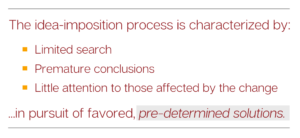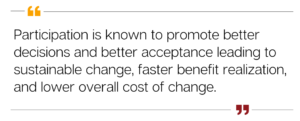4 Minute Read
Takeaway: Decisions primarily fail because of a poor decision-making process. Decisions dictated by a formal authority with little discovery and participation are risky. Information is limited. Stakeholders are unaligned. Be aware that when you think you have the answer, or a high-priced consultant is pitching you a ready-made solution, this is the moment when you are at the highest risk for a decision debacle.
Debacle (n): A decision riddled with poor practices producing big losses that damage careers.
You’ve decided to drive a business solution into your organization. All the rationale is in place: you’re experienced; you need to move fast; you have decision authority; your direction is grounded in careful thought and best-practice guidance from a well-known consulting company. Is a dogged attachment to this preconceived solution leading you and your organization toward a debacle? Is it discomforting to learn that half of the decisions made in business fail?
If you find yourself imposing your solution onto others as you’re met with lukewarm reception or outright resistance, or investing heavily to prove a solution’s validity, then you’re on a dangerous path. Ask yourself three questions:
- If my idea fails, where will the blame land?
- What are the consequences to me personally?
- Am I willing to try a proven, time-tested decision-making process?

Why Do Decisions Fail?
Three categories of interconnected mistakes underlie most failed decisions. The first is a poor decision-making process and a lack of effective decision-making skills. Leaders that believe their job is to quickly identify and drive solutions are conditioned to make this mistake. The second mistake is premature commitment. This is driven by the pressure to move quickly. The third mistake is investment(s) intended to validate a preferred decision.
These broad categories of mistakes promote a recognizable yet correctable chain of events that lead to failed decisions:
- Little to no attempt to validate claims about the underlying nature of a problem
- Poor or missing stakeholder engagement
- Limited or non-existent search for alternative solutions
- Evaluation designed to justify a course of action
These poor practices are often present when leaders take a compliance-centered process that imposes a decision onto an organization. Yet, there is another way with a proven track record of success.
Idea Imposition and “Pay Later”
The strategic choice for decision-making is idea imposition versus discovery and collaboration.

Further, idea imposition is called a “Pay Later” approach and it checks most if not all the boxes of decision failure and implementation debacle. The allure is that the approach seems reasonable and consistent with a traditional view of leadership. When it comes to decision-making in leadership, a leader often gathers a small group of expert decision-makers to efficiently conduct analysis and planning. Stakeholders are seen as important but ultimately individuals or groups are convinced of a plan’s merit. The leader then deploys the decision for others to implement.

Furthermore, the Pay Later approach is often visible in the form of organization restructure. Even in cases where a company has a competent internal organization design capability, leaders prescribe a new organizational structure and give it to the design team to implement. Here are a few of the problems with such an approach aligned to the chain of events leading to decision failures identified above:
- Leaders gain alignment in the top leadership team by presenting a problem in a way that supports the preferred solution as the best logical course of action
- The design process ignores the knowledge and engagement of at least one critical stakeholder group – the employees who must implement the prescribed solution
- Alternative solutions are variations of industry best practice promoted by expert consultants
- Evaluation is presented in narrow but favorable benchmark measures of spans, layers, and expense reduction that justify the solution
Discovery and “Pay Now”
The solution to “Pay Later” is “Pay Now” where discovery stands in contrast to idea imposition. Discovery stresses learning and follows an orderly process to gather information. It validates an understanding of current state, sets clear direction, and aligns stakeholders for implementation. Its hallmark is participative process.

In brief, effective leadership and decision-making require a robust and representative group of decision-makers. Leaders must insist the decision-making process engages a cross-section of the affected organization and powerful stakeholders. They must be willing to let go of the specifics of a solution while being highly involved in setting project requirements, parameters, and constraints. Those in charge must be involved in the process but accept a restricted role. This can be a challenge for those with a traditional leadership mindset and associated behaviors. Effective decisions that achieve acceptance by stakeholders and effective implementation require leadership courage, trust in employees, and personal growth.
Best Practice or “Most Common” Practice?

Moreover, this is a scenario that happens so often, it leads to consultant aversion. The dilemma with the expert consultant model is they often employ pre-conceived ‘best practice’ solutions, that simply don’t apply to all organizations. This plug-and-play exercise is deemed ‘best practice,’ yet it’s truly just the most common practice.
What worked for a similar organization does not work for every organization. The danger here is that it will diminish an organization’s competitive difference and assume information about the organization. No one knows a business better than the people that are in it. For these reasons, expert consulting and most-common practice won’t be enough to create a sustainable operating model transformation. The true best practice is a proven, tailored, and collaborative approach.
It’s The Process That Matters
Decisions primarily fail because of a poor decision-making process. Decisions dictated by a formal authority with little discovery and participation are risky. Information is limited. Stakeholders are unaligned. Be aware that when you think you have the answer, or a high-priced consultant is pitching you a ready-made solution, this is the moment when you are at the highest risk for a decision debacle.

Effective decision-making that leads to effective implementation is based on participation, discovery, alignment, and commitment. Following a discovery process may require a change in leadership mindset. The result is worth it – there is a 50% increase in the probability of decision and implementation success.
“A discovery-driven process will increase your chance of success by 50%.” – Paul Nutt
Sources:
- Nutt, P. C. (2002). Why Decisions Fail: Avoiding the Blunders and Traps that Lead to Debacles. Berrett-Koehler Publishers, Inc.
Dan Schmitz is a Consultant at ON THE MARK. OTM is a global leader in collaborative operating model modernization that creates real change, fast. OTM’s passion for collaborative business transformation is supported by pragmatism, systems thinking, and a belief in people that is unparalleled for 33 years.



